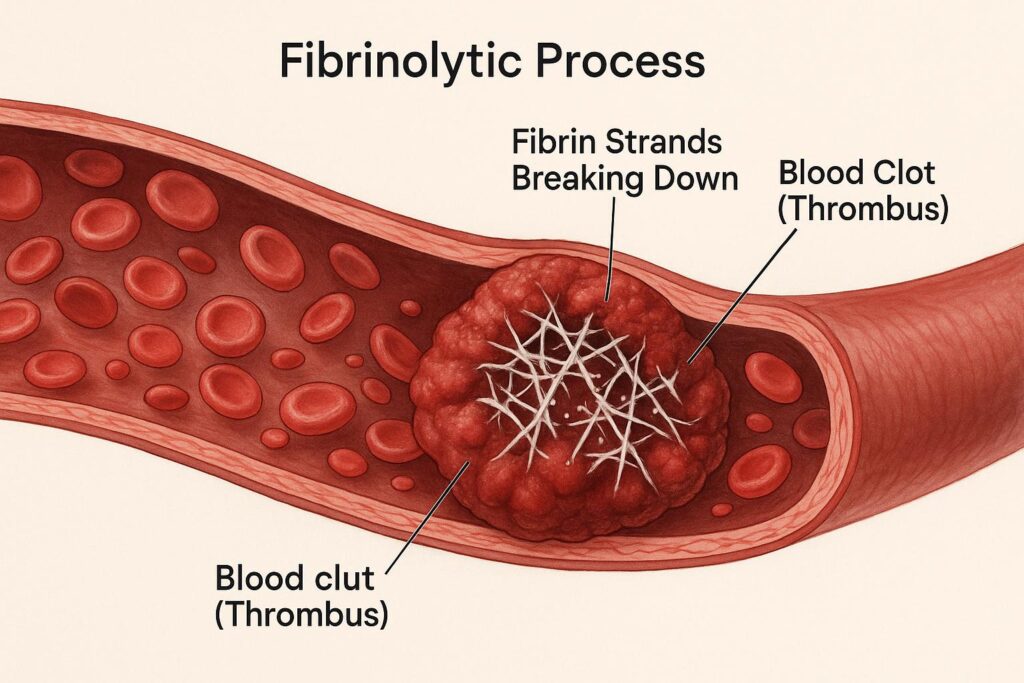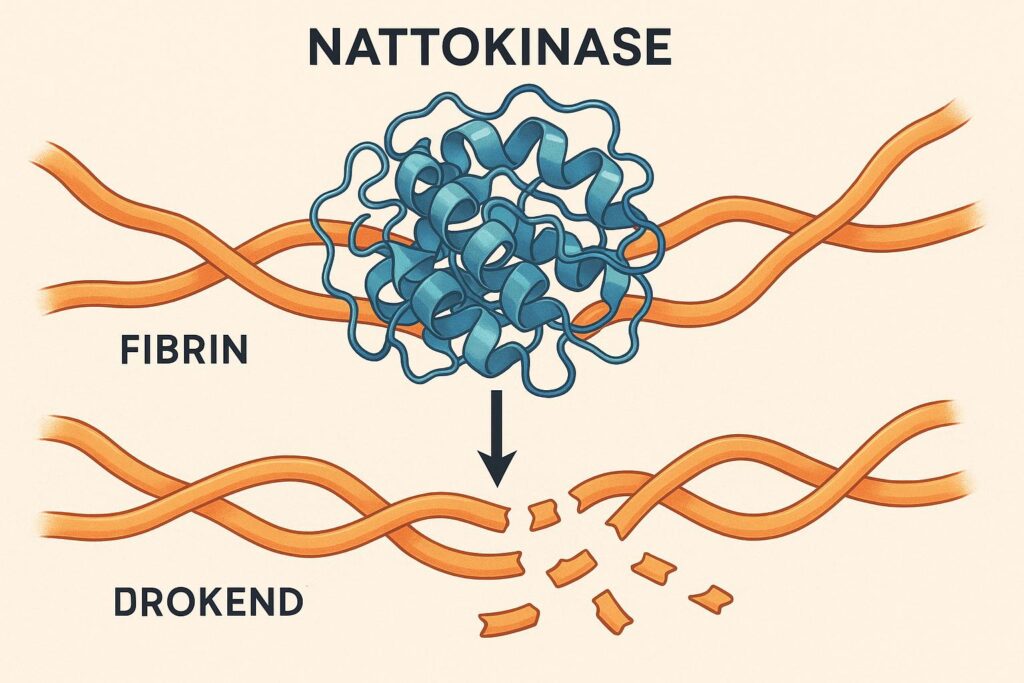“Is it true that natto makes your blood ‘silky-smooth’?”
The most famous health benefit of natto is its “blood-smoothing effect,” and the secret lies in nattokinase, a special enzyme found only in natto. Since its discovery in 1980, it has been studied worldwide for its potential to help prevent thrombotic diseases such as myocardial infarction and cerebral infarction.
This article provides a detailed explanation of the mechanism by which nattokinase dissolves blood clots at the molecular level.
What you’ll learn in this article
- The history of the discovery of nattokinase
- The three mechanisms of thrombolysis
- Differences from other thrombolytic enzymes
- Latest research findings and health benefits
- Intake methods and precautions
The Discovery of Nattokinase
In 1980, Professor Hiroyuki Sumi of Kurashiki University of Science and the Arts accidentally discovered that natto has the ability to dissolve blood clots. When he added natto to an artificially created blood clot, it dissolved in just a few hours. This surprising discovery marked the beginning of nattokinase research.
Subsequent research revealed that the component responsible for this thrombolytic action is an enzyme produced by the natto bacterium (Bacillus subtilis var. natto), and it was named “Nattokinase” [1].
Learn More
In the process of breaking down soybean proteins, the natto bacterium produces various enzymes, including nattokinase. For more on the overall health benefits of natto, please see the related article “The Health Benefits of Natto“.
What is a Thrombus? Why is it Dangerous?
A thrombus, or blood clot, is a mass formed when platelets and a protein called fibrin in the blood clump together. Normally, blood clots are a necessary mechanism to stop bleeding when you get injured, but if they form unnecessarily inside a blood vessel, they can obstruct blood flow and cause serious diseases.
| Disease | Location | Symptoms |
|---|---|---|
| Myocardial Infarction (Heart Attack) | Coronary arteries of the heart | Necrosis of the heart muscle, severe chest pain |
| Cerebral Infarction (Stroke) | Blood vessels in the brain | Necrosis of brain cells, paralysis, speech impairment |
| Pulmonary Embolism | Blood vessels in the lungs | Difficulty breathing, chest pain (Economy Class Syndrome) |
These diseases are among the leading causes of death in Japan, making the prevention of blood clots extremely important.
Nattokinase’s Thrombolytic Mechanism
Nattokinase dissolves blood clots through the following three mechanisms.
Mechanism 1: Direct Degradation of Fibrin
The main component of a blood clot is a protein called “fibrin.” Fibrin envelops platelets in a mesh-like structure, strengthening the clot. Nattokinase acts as a “fibrinolytic enzyme” that directly breaks down this fibrin.
Nattokinase cleaves the peptide bonds of fibrin, breaking it down into smaller fragments. This dissolves the clot and restores blood flow.

Mechanism 2: Activation of Plasminogen
Our bodies have a built-in system for dissolving blood clots, known as the “fibrinolytic system.” In this system, an inactive enzyme called “plasminogen” is converted into an active enzyme called “plasmin,” which then breaks down fibrin.
Nattokinase also has the function of activating this plasminogen. In other words, nattokinase not only breaks down fibrin itself but also activates the body’s own thrombolytic system, providing a dual effect.

Mechanism 3: Degradation of Thrombolysis Inhibitors
The body has a substance called “PAI-1 (Plasminogen Activator Inhibitor)” that acts as a brake to prevent excessive dissolution of blood clots. Nattokinase promotes thrombolysis by breaking down this PAI-1.
| Mechanism | Action | Effect |
|---|---|---|
| Direct Fibrinolysis | Cleaves peptide bonds of fibrin | Directly dissolves blood clots |
| Activation of Plasminogen | Promotes conversion to plasmin | Activates the body’s thrombolytic system |
| Degradation of PAI-1 | Removes thrombolysis inhibitors | Further promotes thrombolysis |
Difference from Other Thrombolytic Enzymes
In clinical settings, a drug called “t-PA (tissue plasminogen activator)” is used to dissolve blood clots. However, t-PA can only be administered by injection, is expensive, and carries a risk of side effects.
On the other hand, nattokinase is a natural enzyme derived from food, can be taken orally, and has few side effects. However, it is important to note that nattokinase is positioned as a health food, not a pharmaceutical drug.
Activity Duration
When nattokinase is ingested, its thrombolytic effect lasts for about 8 to 12 hours. Since blood clots are more likely to form from bedtime to early morning, eating natto for dinner is thought to be an effective way to prevent them.
Latest Research on Nattokinase
1. Antihypertensive Effects
Recent studies have reported that nattokinase has a blood pressure-lowering effect. One study showed a significant decrease in systolic blood pressure in hypertensive patients after eight weeks of nattokinase intake [2].
2. Prevention of Arteriosclerosis
Nattokinase has been suggested to improve the flexibility of blood vessels and suppress the progression of arteriosclerosis.
3. Improvement of Cognitive Function
By improving blood flow to the brain, nattokinase is expected to have a preventive effect on cognitive decline.
Nattokinase Intake and Precautions
Recommended Intake
The Japan Nattokinase Association recommends a daily intake of 2000 FU (Fibrinolytic Units) of nattokinase. This is equivalent to about one pack (50g) of natto.
Precautions
| Precaution | Reason | Action |
|---|---|---|
| Use with Anticoagulants | Vitamin K2 weakens the effect of Warfarin | Avoid natto while taking Warfarin |
| Caution with Heat | Loses activity above 70°C (158°F) | Eat natto without heating |
| Intake Before Surgery | Increases bleeding risk | Refrain from intake one week before surgery |
Nattokinase Intake Other Than Natto
For those who dislike natto or are taking Warfarin, nattokinase supplements with Vitamin K2 removed are available. When choosing a supplement, it is recommended to select a product with the certification mark of the Japan Nattokinase Association.
Summary
Nattokinase is a special enzyme found only in natto that has a powerful ability to dissolve blood clots. Through three mechanisms—direct fibrinolysis, activation of plasminogen, and degradation of PAI-1—it may help prevent thrombotic diseases.
- Nattokinase dissolves blood clots through three mechanisms
- It is a natural, food-derived enzyme that can be taken orally
- New effects such as blood pressure reduction and prevention of arteriosclerosis are being reported in the latest research
- Caution is required when used with anticoagulants or when heated
It is fascinating that natto, a traditional Japanese fermented food, is also gaining attention in cutting-edge medical research. Isn’t it wonderful that we can maintain our health deliciously by incorporating natto into our daily diet?
References
- Sumi, H., et al. (1987). A novel fibrinolytic enzyme (nattokinase) in the vegetable cheese Natto. Experientia, 43(10), 1110-1111.
- Kim, J. Y., et al. (2008). Effects of nattokinase on blood pressure. Hypertension Research, 31(8), 1583-1588.
- Japan Nattokinase Association. “What is Nattokinase?”


